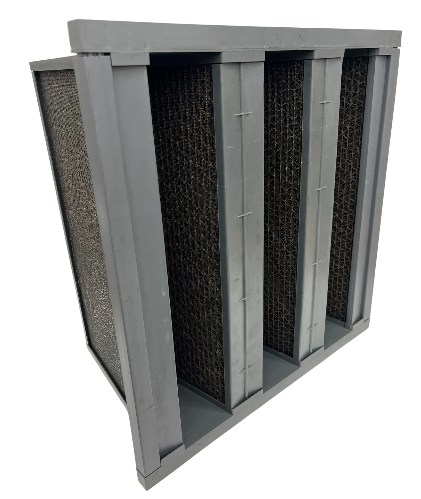What Does a Carbon Filter Do?
What is a Carbon Filter?
A carbon filter, interchangeable with charcoal filter, is very popular for odor and VOCs removal and may be the right choice for you if you are looking for an air purification solution.
Carbon fragments.
Carbon and charcoal filters get their name from the carbon leftover from a burned material, such as wood. Activated carbon or charcoal has an additional industrial process that has made it more effective at trapping gasses. The process itself involves injecting either hot air, carbon dioxide, or steam into the carbon substance to create a porous structure, which exponentially increases the surface area. This is an important piece, since increasing the surface area also increases the space to trap molecules. Most remarkably, a single gram of activated carbon has a surface area that can meet 32,000 square feet. Carbon filters work through adsorption, where molecules stick to the surface of the carbon matrix.
What are Different Types of Carbon Filters?
Example of a MERV-8, carbon-pleated pre-filter cleaning the air of odors, fumes, VOCs, and particles, resulting in clean air.
There are a wide variety of different carbon filters available on the market today. You could opt for a pleated carbon filter, which has activated carbon bonded to a MERV-8 pre-filter medium. This is a great option for when you also want maximum particulate and germ reduction as you can have a HEPA filter in your purifier, while also getting some odor and VOCs relief from the carbon pre-filter.
Another option that would provide greater odor and fume relief would be to implement a V-Bank activated carbon filter. Designed to efficiently remove gaseous pollutants at high airflows, V-Bank filters provide a long-life option that provides optimal odor, fume, and VOCs elimination.
What are Carbon Filters Used For?
Carbon Filters Reduce Fumes and Odors
Carbon filters can reduce fumes and odors, such as diesel, tobacco and wildfire smoke, pet odors, odors from cooking activities, auto exhaust, off-gassing, and more. This can be all the more important in a commercial setting, where fumes can be detrimental to occupant health.
Carbon Filters Reduce Gasses
In addition to fumes and odors, carbon filters can also reduce gasses including those produced from acetone, paint fumes, gasoline, SOx, NOx, Volatile Organic Compounds (VOCs), and even ozone. Common VOCs that carbon filters can capture include formaldehyde, benzene, toluene, and xylene.
Carbon Filters can Capture Some Particles
Although the primary reason for why people choose carbon filters are for odor, fume, and VOCs control, carbon filters are able to capture both small and large particles, but do best at capturing larger particles. The size of the pores in the carbon determines the size of the particle that it can trap, with the smaller the pore, the smaller the particle that it can trap. A great way to still trap particles but prolong the life of the carbon filter would be to make sure that there is a pre-filter. Pet hair, dander, pollen, lint, dust, are all examples of what a carbon filter can capture very well. If your main indoor air quality is about maximum particle reduction, you may want to consider HEPA filtration.
What to Look for in a Carbon Filter
Example of a V-Bank carbon filter.
When trying to determine what to choose for a carbon filter, there are a few things to consider. First, if you are looking for a carbon filtration option for your furnace, you may be limited in your options. Verify the MERV rating that your furnace can handle. One option is to look for a pleated carbon filter with the appropriate MERV rating for your furnace. If your primary goal is to get an activated carbon filter with a much greater capacity of filtering odors, fumes, VOCs, smoke, etc., you will want to consider a standalone purifier that can handle a greater capacity carbon filter, like the V-Bank filter mentioned above. This is typically what is the easiest and most cost-efficient option, as the purifier’s main goal can be dedicated to odor relief.
ISO-Aire Carbon Air Purifiers
At ISO-Aire we are able to provide all of our HEPA air purifier models with a MERV-8 pleated activated carbon filter. This is a great option for those looking for HEPA filtration but also the capability to reduce odors and VOCs. For those with the main goal of eliminating odors and dangerous gasses, we are able to provide our RSF and our RSH series with an activated V-bank carbon filter instead of the HEPA filter. This option is available for our RSF500I, RSF1000I, RSP1000I and in our hanging models, the RSH800I and RSH1000I. All of our carbon models also include ozone-free bipolar ionization to provide maximum odor and VOCs reduction, and are guaranteed to produce no ozone. Our carbon series also come equipped with a MERV-9 pre-filter which extends the life of the carbon filter and provides particle and germ reduction.
Interested in learning which one of our carbon purifier models might be right for you? Check out our at-a-glance chart featuring our portable models or our hanging models to learn what each model can provide or contact our team of air quality specialists at 651-265-0605 or at info@iso-aire.com.
ISO-Aire Carbon Air Purifiers





